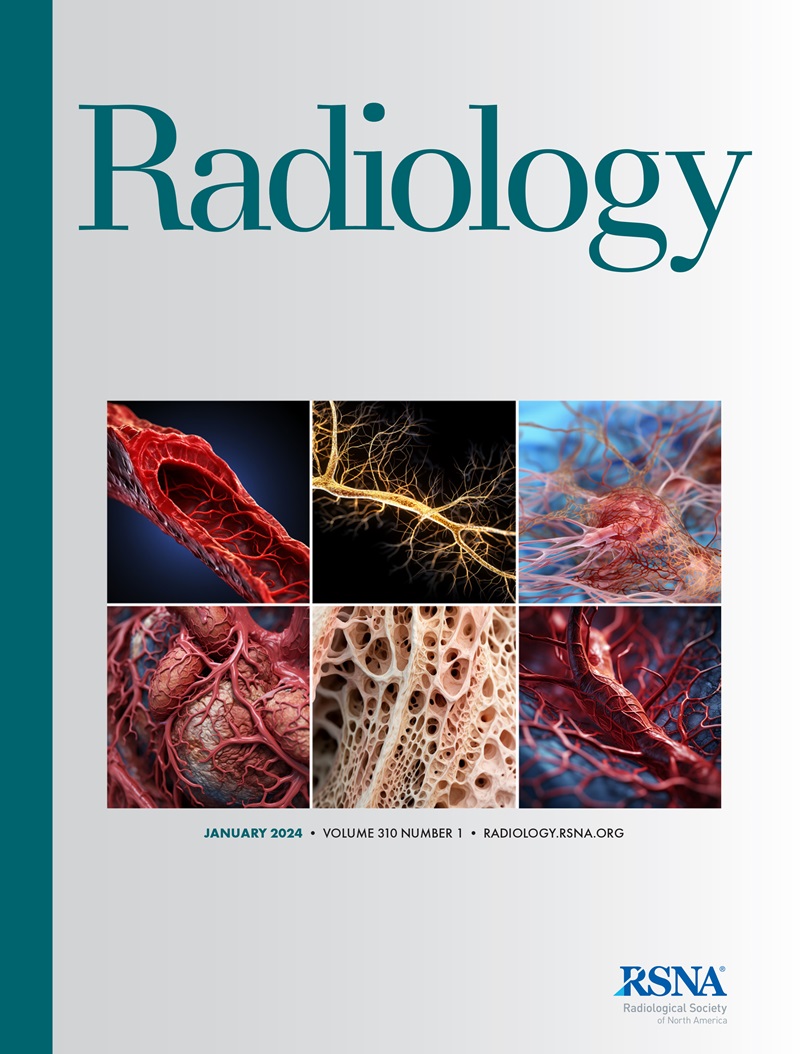Texture Analysis with 3.0-T MRI for Association of Response to Neoadjuvant Chemotherapy in Breast Cancer.
IF 15.2
1区 医学
Q1 RADIOLOGY, NUCLEAR MEDICINE & MEDICAL IMAGING
引用次数: 60
Abstract
Background Previous studies have suggested that texture analysis is a promising tool in the diagnosis, characterization, and assessment of treatment response in various cancer types. Therefore, application of texture analysis may be helpful for early prediction of pathologic response in breast cancer. Purpose To investigate whether texture analysis of features from MRI is associated with pathologic complete response (pCR) to neoadjuvant chemotherapy (NAC) in breast cancer. Materials and Methods This retrospective study included 136 women (mean age, 47.9 years; range, 31-70 years) who underwent NAC and subsequent surgery for breast cancer between January 2012 and August 2017. Patients were monitored with 3.0-T MRI before (pretreatment) and after (midtreatment) three or four cycles of NAC. Texture analysis was performed at pre- and midtreatment T2-weighted MRI, contrast material-enhanced T1-weighted MRI, diffusion-weighted MRI, and apparent diffusion coefficient (ADC) mapping by using commercial software. A random forest method was applied to build a predictive model for classifying those with pCR with use of texture parameters. Diagnostic performance for predicting pCR was assessed and compared with that of six other machine learning classifiers (adaptive boosting, decision tree, k-nearest neighbor, linear support vector machine, naive Bayes, and linear discriminant analysis) by using the Wald test and DeLong method. Results Forty of the 136 patients (29%) achieved pCR after NAC. In the prediction of pCR, the random forest classifier showed the lowest diagnostic performance with pretreatment ADC (area under the receiver operating characteristic curve [AUC], 0.53; 95% confidence interval: 0.44, 0.61) and the highest diagnostic performance with midtreatment contrast-enhanced T1-weighted MRI (AUC, 0.82; 95% confidence interval: 0.74, 0.88) among pre- and midtreatment T2-weighted MRI, contrast-enhanced T1-weighted MRI, diffusion-weighted MRI, and ADC mapping. Conclusion Texture parameters using a random forest method of contrast-enhanced T1-weighted MRI at midtreatment of neoadjuvant chemotherapy were valuable and associated with pathologic complete response in breast cancer. © RSNA, 2019 Online supplemental material is available for this article.3.0T MRI纹理分析与癌症新辅助化疗反应的相关性。
背景先前的研究表明,纹理分析在诊断、表征和评估各种癌症类型的治疗反应方面是一种很有前途的工具。因此,纹理分析的应用可能有助于早期预测癌症的病理反应。目的探讨MRI特征的纹理分析是否与癌症新辅助化疗(NAC)的病理完全反应(pCR)有关。材料和方法这项回顾性研究包括136名女性(平均年龄47.9岁;范围31-70岁),她们在2012年1月至2017年8月期间接受了NAC和随后的乳腺癌手术。在NAC的三个或四个周期之前(治疗前)和之后(治疗中期),对患者进行3.0T MRI监测。使用商业软件在治疗前和治疗中期进行T2加权MRI、对比剂增强T1加权MRI、扩散加权MRI和表观扩散系数(ADC)标测时进行纹理分析。应用随机森林方法建立预测模型,利用纹理参数对pCR患者进行分类。通过使用Wald检验和DeLong方法,评估了预测pCR的诊断性能,并将其与其他六种机器学习分类器(自适应提升、决策树、k近邻、线性支持向量机、朴素贝叶斯和线性判别分析)的诊断性能进行了比较。结果136例患者中有40例(29%)NAC后获得pCR。在pCR的预测中,随机森林分类器在治疗前和治疗中期T2加权MRI中显示出治疗前ADC的最低诊断性能(受试者工作特征曲线下面积[AUC],0.53;95%置信区间:0.44,0.61)和治疗中期对比增强T1加权MRI的最高诊断性能(AUC,0.82;95%可信区间:0.74,0.88),对比增强T1加权MRI、扩散加权MRI和ADC标测。结论随机森林法增强T1加权MRI纹理参数在癌症新辅助化疗中期的应用是有价值的,并与病理完全反应有关。©RSNA,2019本文提供在线补充材料。
本文章由计算机程序翻译,如有差异,请以英文原文为准。
求助全文
约1分钟内获得全文
求助全文
来源期刊

Radiology
医学-核医学
CiteScore
35.20
自引率
3.00%
发文量
596
审稿时长
3.6 months
期刊介绍:
Published regularly since 1923 by the Radiological Society of North America (RSNA), Radiology has long been recognized as the authoritative reference for the most current, clinically relevant and highest quality research in the field of radiology. Each month the journal publishes approximately 240 pages of peer-reviewed original research, authoritative reviews, well-balanced commentary on significant articles, and expert opinion on new techniques and technologies.
Radiology publishes cutting edge and impactful imaging research articles in radiology and medical imaging in order to help improve human health.
 求助内容:
求助内容: 应助结果提醒方式:
应助结果提醒方式:


